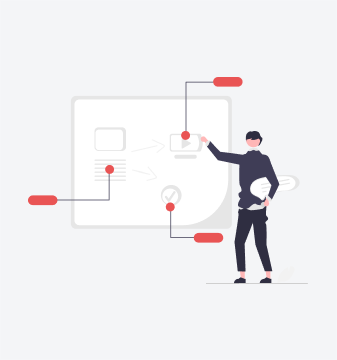Drawing insights from large datasets can be quite challenging for data scientists. That’s where the concept of cluster analysis comes into play. Clustering involves classifying data with some commonalities into the same group to easily analyze and interpret large data sets. If you aim to establish a career in data science, understand the basics of cluster analysis from this article.

The Concept of Cluster Analysis
Clustering is a statistical technique to classify data points according to similar features or variables. The key objective of cluster analysis is to recognize meaningful patterns and relationships and draw valuable insights from them. Therefore, it is useful for organizing massive volumes of unstructured data.
Clustering is considered a form of unsupervised machine learning. An unsupervised learning method looks for patterns in a dataset with no pre-existing labels. The primary characteristic of unsupervised machine learning is minimal human intervention.

The Process of Cluster Analysis
The clustering process cannot be performed with a single algorithm. Instead, multiple algorithms considerably different from one another are used for the purpose of analysis. An ideal clustering algorithm will form clusters with high intra-cluster similarity. Therefore, the data inside one cluster will be similar.
At the same time, the algorithm will have to create clusters with low inter-cluster similarity. Therefore, the data in one cluster will be significantly different from another.
More than 100 clustering algorithms have been published to date. Every data scientist has a different notion of what a cluster should include and how it should be defined. But an algorithm designed for a specific type of cluster model won’t be useful for creating a different type of cluster model.
Different Types of Clustering
The different types of clustering methods used in data science are as follows:
-
Hierarchical Clustering
Hierarchical clustering involves assessing data clusters using different scales and distances. This approach involves creating a tree with different hierarchical levels containing small clusters. The neighboring clusters with similar features from each hierarchical level are classified together. The process continues as long as only one cluster is left at the hierarchical level.
-
Partitioning Clustering
Partitioning clustering treats each data point in a cluster as objects with a specific location and distance from one another. The partitioning takes place in such a way that objects with similar features remain close to one another. Therefore, the objects in other clusters remain far from one another.
-
Model-Based Clustering
The model-based clustering system hypothesizes all the clusters to determine the data suitable for the model. The clusters of a given model can be found with the density function. It reveals how different data points are distributed spatially. The model-based clustering method also helps automatically determine the number of clusters according to standard statistics.
-
Grid-Based Clustering
The grid-based clustering method involves forming a grid with different objects. Dividing the object space into a limited number of cells can help create a grid structure. The popularity of the grid-based cluster analysis method can be attributed to the fast processing time. The dependence on a limited number of cells in each dimension can lead to faster processing time.
-
Density-Based Clustering
The density-based clustering makes a cluster grow continuously until the density in the neighborhood doesn’t cross a particular threshold, which is the data point within a cluster. The radius of the cluster should contain at least two data points.

Advantages
The different advantages of clustering are as follows:
- Cluster analysis in data science helps with identifying patterns and relationships in a dataset that aren’t obvious.
- The cluster analysis methods are useful for drawing insights from exploratory data and can aid in feature selection.
- Clustering can reduce data dimensionality.
- Cluster analysis is useful for detecting anomalies and identifying outliers.
- Clustering can help with market segmentation and customer profiling.
Disadvantages
While clustering is advantageous, it also has some drawbacks:
- Cluster analysis is sensitive to the number of clusters and the initially chosen conditions.
- Clustering might be sensitive to noise or outliers present in data.
- Interpreting the results of cluster analysis can be a little difficult without well-defined clusters.
- Cluster analysis proves to be extremely expensive for large volumes of data.
- The outcome of cluster analysis is influenced by the chosen clustering algorithm.
- The success of clustering is influenced by the data, the goals of the analysis, and how the analysis interprets the results.
Applications
The different types of clustering algorithms available have led to the application of cluster analysis in different businesses. Some real-life use cases of clustering in data science are as follows:
-
Network Traffic Classification
Organizations need to understand the different types of traffic present on their website. It helps organizations identify spam and traffic coming from bots. Clustering is extremely useful for grouping together traffic sources with similar characteristics. It helps with blocking unwanted traffic and driving traffic from desired sources.
-
Document Analysis
Several organizations have to deal with high volumes of documents regularly. The cluster analysis technique can be used to organize documents efficiently. It helps understand the themes of documents so that they can be compared with others.
Clustering algorithms scan text in documents to classify them into groups of different themes. It ensures that the documents can be organized faster according to the actual content.
-
Marketing and Sales
The success of marketing campaigns largely depends on targeting the right audience. Marketing professionals can use cluster analysis to group together with similar characteristics, particularly according to their buying intent. The defined clusters make it easy to test marketing campaigns and make the necessary changes.

-
Search Engines
Are you aware of the image search feature on Google? In this search mechanism, Google applies a clustering algorithm to all the images available in a database. After the cluster analysis is performed, all the similar images come under one cluster.
When a user provides a reference image, Google applies the trained clustering model to recognize its cluster. After that, Google shows all the images from this particular cluster.
-
Image Segmentation
Clustering enables you to segment pixels according to their colors. After that, you can replace a pixel with the mean color of the cluster. It is particularly useful when you need to minimize the number of colors in an image. Image detection has a huge role to play in tracking systems and object detection.
-
Anomaly Detection
The measure of the accuracy of an instance in a particular cluster is called affinity. Any instance with a low affinity can be identified as an anomaly. For instance, you can find users with abnormal behavior when you cluster users according to the request per minute on your website. The feature of anomaly detection is particularly useful for spotting manufacturing defects and stopping fraud.
-
Semi-Supervised Learning
In semi-supervised learning, you might be given only a few labels. In this scenario, clustering helps you generate labels for all instances in the same cluster. After increasing the number of levels, a supervised learning algorithm can be used for improved performance.
Ending Note
The process of cluster analysis is intuitive but also tricky at times. However, it is still an extremely useful and versatile data science method. Therefore, learning cluster analysis techniques can significantly improve the career of a data science professional.
FAQs:
- How can you increase the accuracy of your cluster analysis?
You need to focus on cluster tendency and clustering quality to maintain the accuracy of cluster analysis. Clustering tendency reveals whether the clusters have any grouping structure. The presence of an inherent grouping structure guarantees the success of your cluster analysis. Clustering quality involves determining the similarities between different clusters. Additionally, the number of clusters will also determine the success and accuracy of your clustering project.
- What type of data is necessary for clustering?
Clustering can be performed on different types of data, including nominal, binary, and ordinal data. Sometimes, clustering is performed on a combination of all these data types. But labeled data is not required for clustering.
- Which clustering technique is the most popular?
K-means clustering is the most popular algorithm for cluster analysis. The centroid-based method is the easiest unsupervised learning algorithm. The aim of this algorithm is to reduce data point variance inside a cluster.
- What is a real-life example of cluster analysis?
A real-life example of cluster analysis is retail marketing. Several retail companies employ clustering to classify similar groups of households. To do so, the retail company will gather information like household size, income, and more.
- What should be the next step after clustering?
After cluster analysis, you need to implement cluster profiling. You should opt for a logical process to cluster and profile your data. After cluster analysis and profiling, you should focus on creating assortment plans for each cluster.



